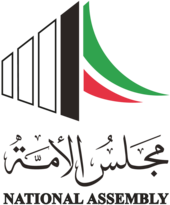

National Assembly of Kuwait مجلس الأمة الكويتي
Majlis al-ʾUmma al-Kuwaytiyy
| |
|---|---|

Logo used to represent the National Assembly
| |
| Type | |
| Type | |
Term limits | None |
| Leadership | |
Mishal Al-Ahmad Al-Jaber Al-Sabah | |
Ibrahim Al-Waleed Al-Salim Al-Sabah | |
Mohamed Al-Abdullah Al-Hassan Al-Sabah | |
Secretary | |
Controller | Faisal Al-Mishal Al-Ahmad Al-Sabah |
| Structure | |
| Seats | 50 elected members Up to 16 appointed members |
Length of term | Four years |
| Elections | |
| Single non-transferable vote | |
Last election | April 4, 2024 |
| Meeting place | |
| Kuwait National Assembly Building, Kuwait City, Kuwait 29°22′13″N 47°57′50″E / 29.37028°N 47.96389°E / 29.37028; 47.96389 | |
| Website | |
| kna | |
 |
|---|
|
|
| Constitution |
|
Monarchy
|
|
|
|
Judiciary |
|
Administration |
|
|
|
Related topics |
|
|
|
|
The National Assembly (Arabic: مجلس الأمة) was[1] the unicameral legislatureofKuwait. The National Assembly met in Kuwait City. The National Assembly was made up of 50 elected members and 16 directly appointed government ministers (ex officio members).[2]
The assembly was frequently dissolved by the Emir of Kuwait. From 2006 to 2024, the assembly was dissolved 13 times.[3] The assembly has been suspended since 10 May 2024.[4][5] The Emir now has full control over the legislation.[4][1]
The National Assembly was the legislature in Kuwait, established in 1963.[6] Its predecessor, the 1938 National Assembly, was formally dissolved in 1939 after "one member, Sulaiman al-Adasani, in possession of a letter, signed by other Assembly members, addressed to Iraq's King Ghazi, requesting Kuwait's immediate incorporation into Iraq." This demand came after the merchant members of the Assembly attempted to extract oil money from Ahmad Al-Jaber Al-Sabah, a suggestion refused by him and upon which he instigated a crackdown which arrested the Assembly members in 1939.[7]
The National Assembly normally consisted of 65 members; this total included 50 elected deputies as well as 15 cabinet members directly appointed by the Emir.[8] Fifty deputies were elected by one non-transferable vote to serve four-year terms. Members of the cabinet also sat in the parliament as deputies. The constitution limits the size of the cabinet to 16. The cabinet ministers had the same rights as the elected MPs, with the following two exceptions: they did not participate in the work of committees, and they could not vote when an interpolation leads to a no-confidence vote against one of the cabinet members. As per Article 107 of the Kuwait constitution, the National Assembly can be dissolved by the Emir by decree, giving the reasons for the dissolution. However, the National Assembly shall not be dissolved again on the same grounds, and elections for the new Assembly must be held within a period not exceeding two months from the date of the dissolution.[9]
The National Assembly was nominally elected because it operated in an authoritarian context where the Emir of Kuwait dominated politics with the ability to dissolve the assembly.[10] However, in contrast to parliaments in other Gulf kingdoms, the Kuwaiti assembly had considerably more formal and informal power than elsewhere in the region.[3]
The assembly was previously suspended from 1976-1981 and 1986-1991.[3]
Kuwaiti women gained the right to vote in 2005. Women first won seats in the National Assembly in the 2009 election, in which four women, Aseel al-Awadhi, Rola Dashti, Massouma al-Mubarak and Salwa al-Jassar, were elected.
The parliament building was designed by Danish architect Jørn Utzon, who also designed the Sydney Opera House.
While political parties were not legal in Kuwait, a number of political factions existed. The house was composed of different political factions:
Kuwait's final 2024 elections witnessed an increase in voter turnout.[11]
{{cite book}}: CS1 maint: location missing publisher (link)
|
National unicameral legislatures
| |
|---|---|
| Federal |
|
| Unitary |
|
| Dependent and other territories |
|
| Non-UN states |
|
| Historical |
|
| Related |
|
| |
| International |
|
|---|---|
| National |
|